Developing Leadership and Management: A Detailed Analysis and Report
VerifiedAdded on 2023/01/11
|19
|4590
|23
Report
AI Summary
This report provides a comprehensive overview of leadership and management, exploring the key differences and similarities between the two concepts. It delves into the roles and responsibilities of leaders and managers, highlighting essential skills and qualities. The report examines various leadership styles, including democratic, autocratic, laissez-faire, strategic, transformational, transactional, coach-style, and bureaucratic leadership, providing detailed insights into their characteristics and applications. It also includes a case study of Robert Mueller, analyzing his leadership principles and practices. The report emphasizes the importance of adapting leadership approaches to different situations and the need for leaders to possess both personal and administrative skills. The report also highlights the roles and responsibilities of managers in providing technical guidance and managing daily activities. Ultimately, the report aims to provide a clear understanding of leadership and management and their impact on organizational success.
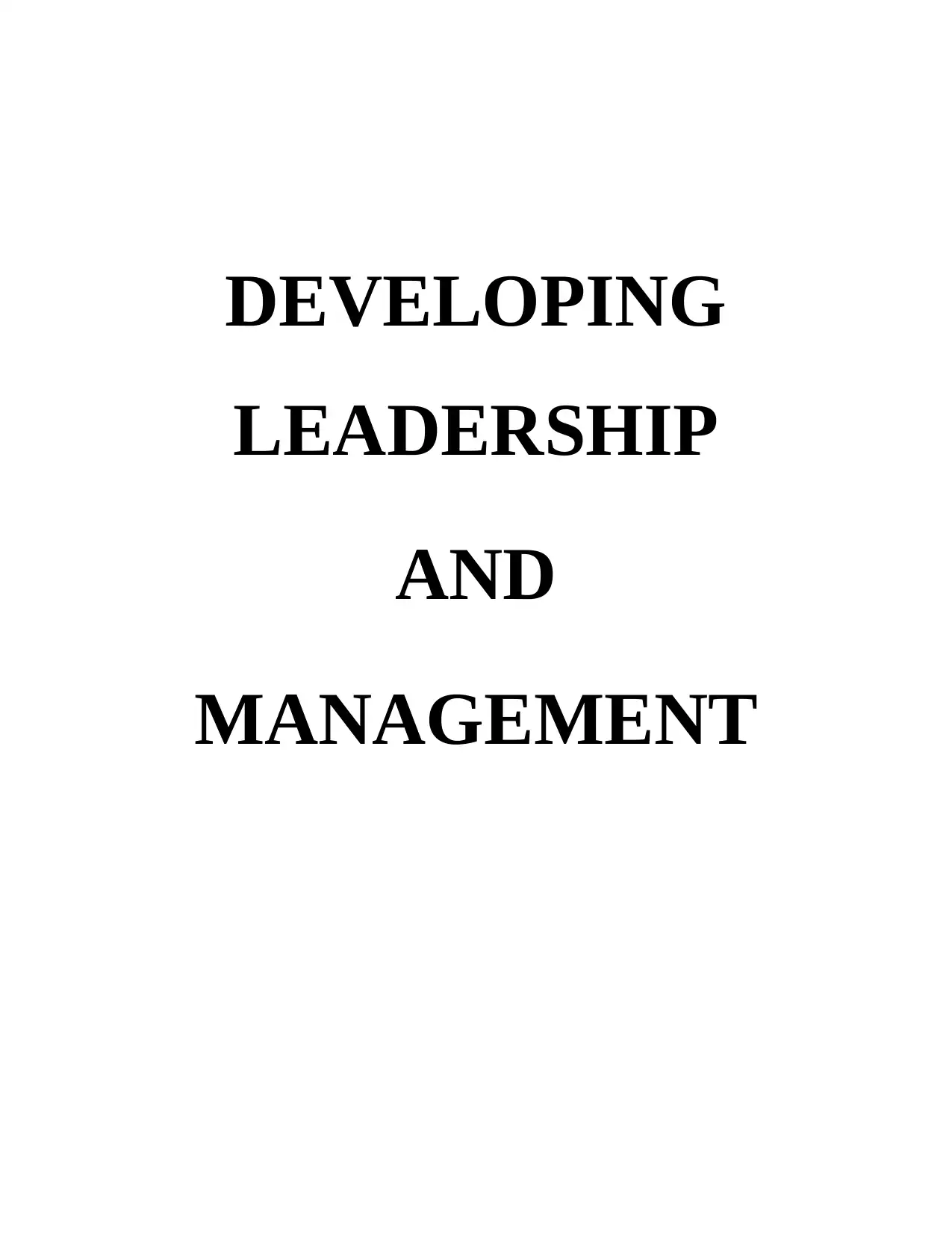
DEVELOPING
LEADERSHIP
AND
MANAGEMENT
LEADERSHIP
AND
MANAGEMENT
Paraphrase This Document
Need a fresh take? Get an instant paraphrase of this document with our AI Paraphraser

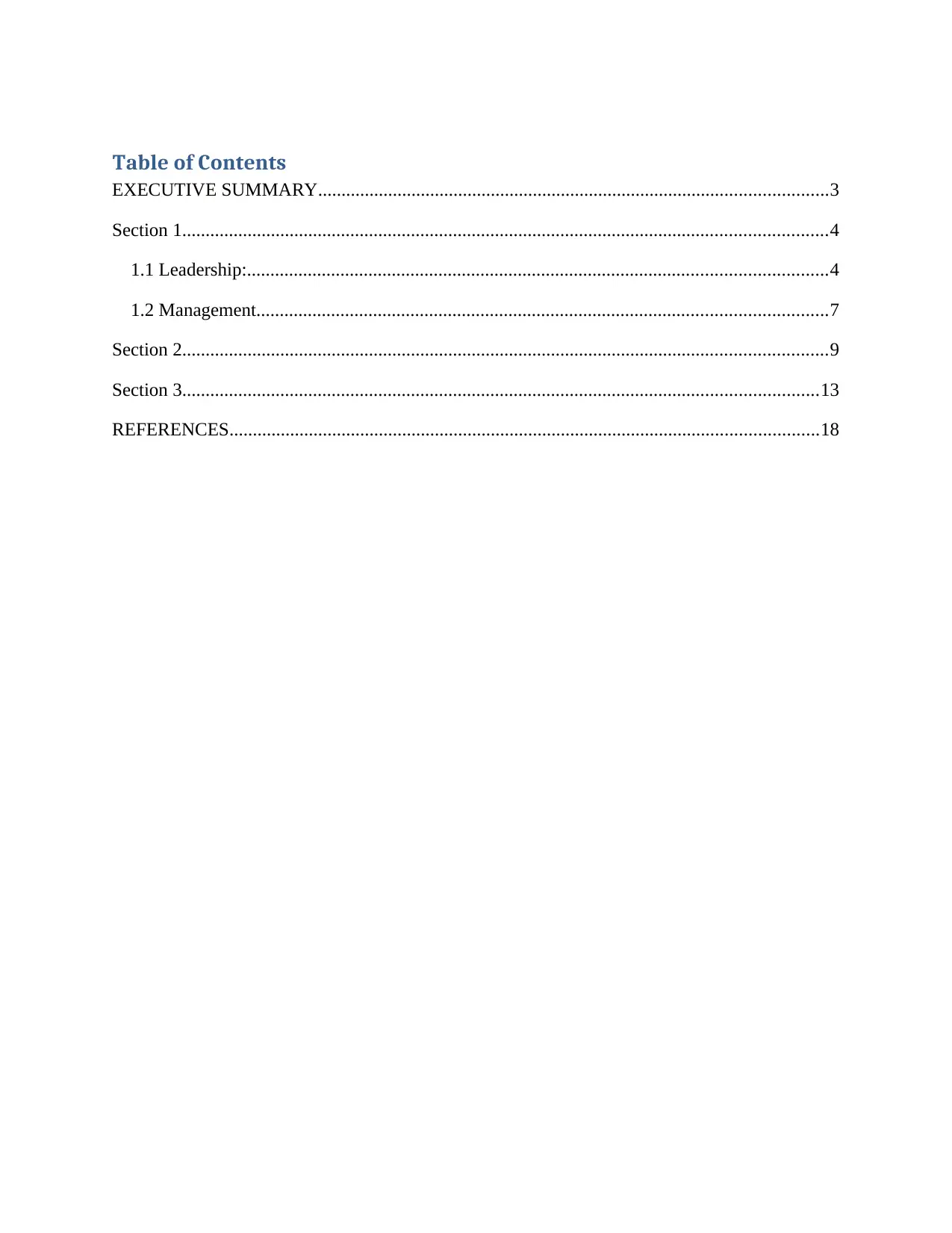
Table of Contents
EXECUTIVE SUMMARY.............................................................................................................3
Section 1..........................................................................................................................................4
1.1 Leadership:............................................................................................................................4
1.2 Management..........................................................................................................................7
Section 2..........................................................................................................................................9
Section 3........................................................................................................................................13
REFERENCES..............................................................................................................................18
EXECUTIVE SUMMARY.............................................................................................................3
Section 1..........................................................................................................................................4
1.1 Leadership:............................................................................................................................4
1.2 Management..........................................................................................................................7
Section 2..........................................................................................................................................9
Section 3........................................................................................................................................13
REFERENCES..............................................................................................................................18
⊘ This is a preview!⊘
Do you want full access?
Subscribe today to unlock all pages.

Trusted by 1+ million students worldwide
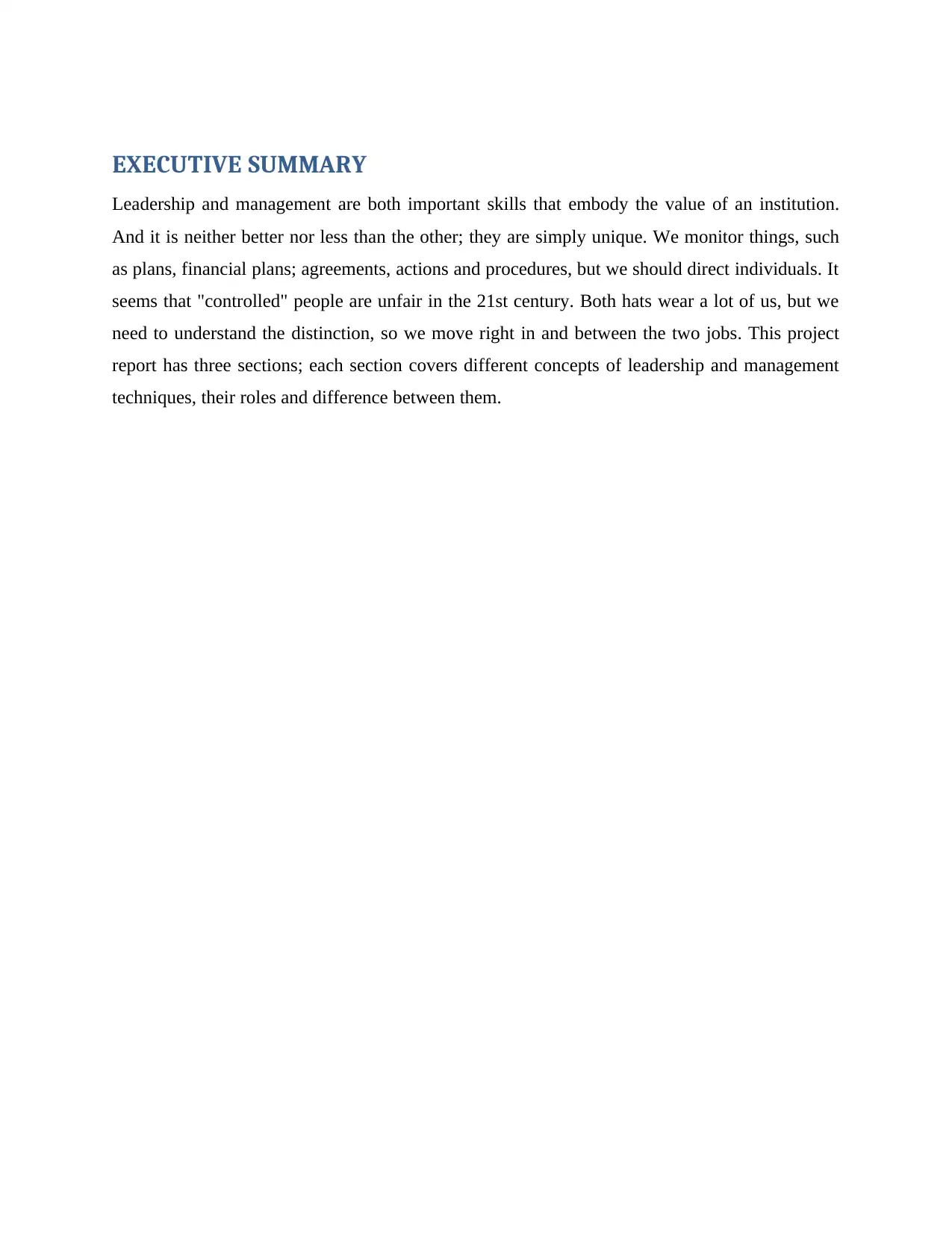
EXECUTIVE SUMMARY
Leadership and management are both important skills that embody the value of an institution.
And it is neither better nor less than the other; they are simply unique. We monitor things, such
as plans, financial plans; agreements, actions and procedures, but we should direct individuals. It
seems that "controlled" people are unfair in the 21st century. Both hats wear a lot of us, but we
need to understand the distinction, so we move right in and between the two jobs. This project
report has three sections; each section covers different concepts of leadership and management
techniques, their roles and difference between them.
Leadership and management are both important skills that embody the value of an institution.
And it is neither better nor less than the other; they are simply unique. We monitor things, such
as plans, financial plans; agreements, actions and procedures, but we should direct individuals. It
seems that "controlled" people are unfair in the 21st century. Both hats wear a lot of us, but we
need to understand the distinction, so we move right in and between the two jobs. This project
report has three sections; each section covers different concepts of leadership and management
techniques, their roles and difference between them.
Paraphrase This Document
Need a fresh take? Get an instant paraphrase of this document with our AI Paraphraser
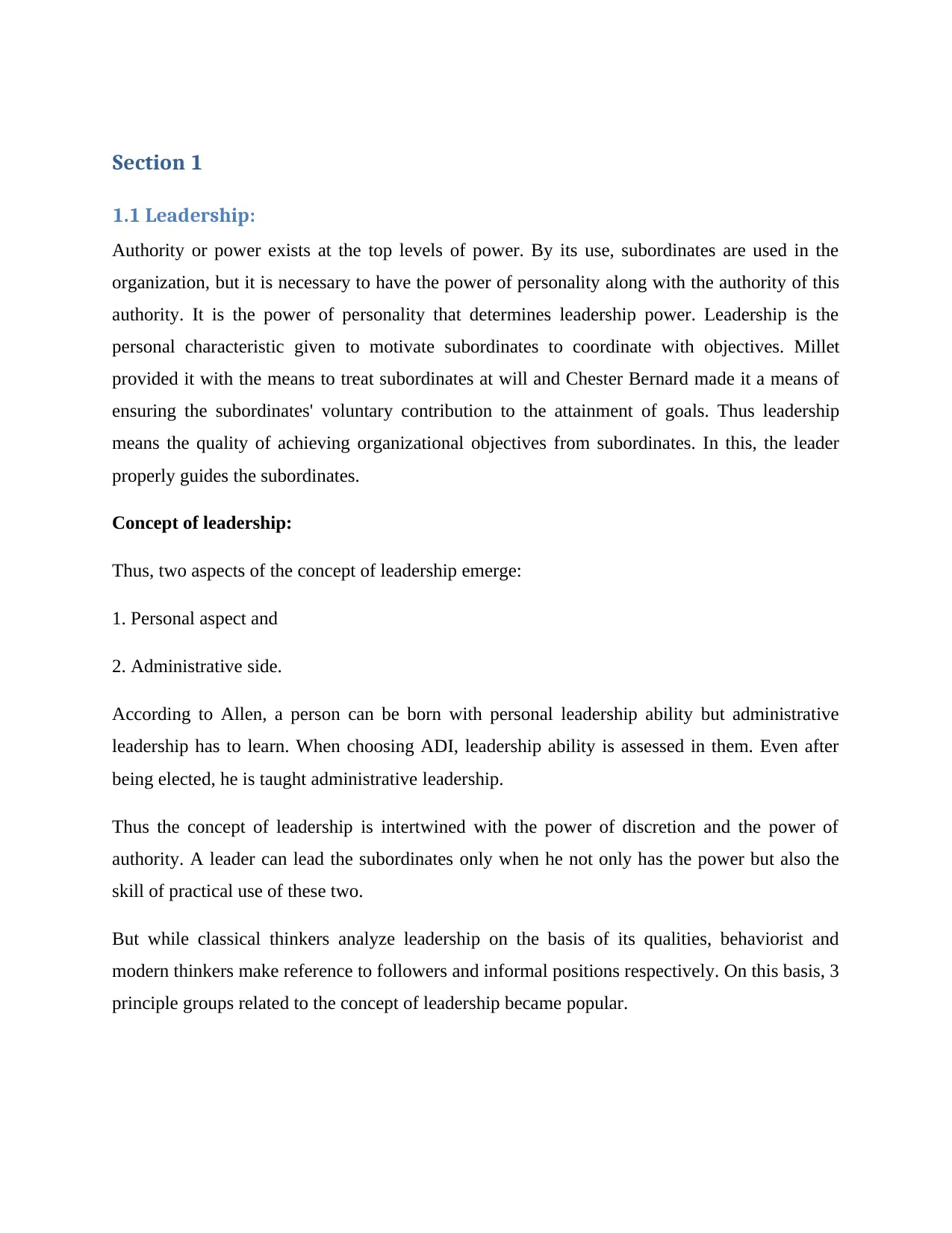
Section 1
1.1 Leadership:
Authority or power exists at the top levels of power. By its use, subordinates are used in the
organization, but it is necessary to have the power of personality along with the authority of this
authority. It is the power of personality that determines leadership power. Leadership is the
personal characteristic given to motivate subordinates to coordinate with objectives. Millet
provided it with the means to treat subordinates at will and Chester Bernard made it a means of
ensuring the subordinates' voluntary contribution to the attainment of goals. Thus leadership
means the quality of achieving organizational objectives from subordinates. In this, the leader
properly guides the subordinates.
Concept of leadership:
Thus, two aspects of the concept of leadership emerge:
1. Personal aspect and
2. Administrative side.
According to Allen, a person can be born with personal leadership ability but administrative
leadership has to learn. When choosing ADI, leadership ability is assessed in them. Even after
being elected, he is taught administrative leadership.
Thus the concept of leadership is intertwined with the power of discretion and the power of
authority. A leader can lead the subordinates only when he not only has the power but also the
skill of practical use of these two.
But while classical thinkers analyze leadership on the basis of its qualities, behaviorist and
modern thinkers make reference to followers and informal positions respectively. On this basis, 3
principle groups related to the concept of leadership became popular.
1.1 Leadership:
Authority or power exists at the top levels of power. By its use, subordinates are used in the
organization, but it is necessary to have the power of personality along with the authority of this
authority. It is the power of personality that determines leadership power. Leadership is the
personal characteristic given to motivate subordinates to coordinate with objectives. Millet
provided it with the means to treat subordinates at will and Chester Bernard made it a means of
ensuring the subordinates' voluntary contribution to the attainment of goals. Thus leadership
means the quality of achieving organizational objectives from subordinates. In this, the leader
properly guides the subordinates.
Concept of leadership:
Thus, two aspects of the concept of leadership emerge:
1. Personal aspect and
2. Administrative side.
According to Allen, a person can be born with personal leadership ability but administrative
leadership has to learn. When choosing ADI, leadership ability is assessed in them. Even after
being elected, he is taught administrative leadership.
Thus the concept of leadership is intertwined with the power of discretion and the power of
authority. A leader can lead the subordinates only when he not only has the power but also the
skill of practical use of these two.
But while classical thinkers analyze leadership on the basis of its qualities, behaviorist and
modern thinkers make reference to followers and informal positions respectively. On this basis, 3
principle groups related to the concept of leadership became popular.
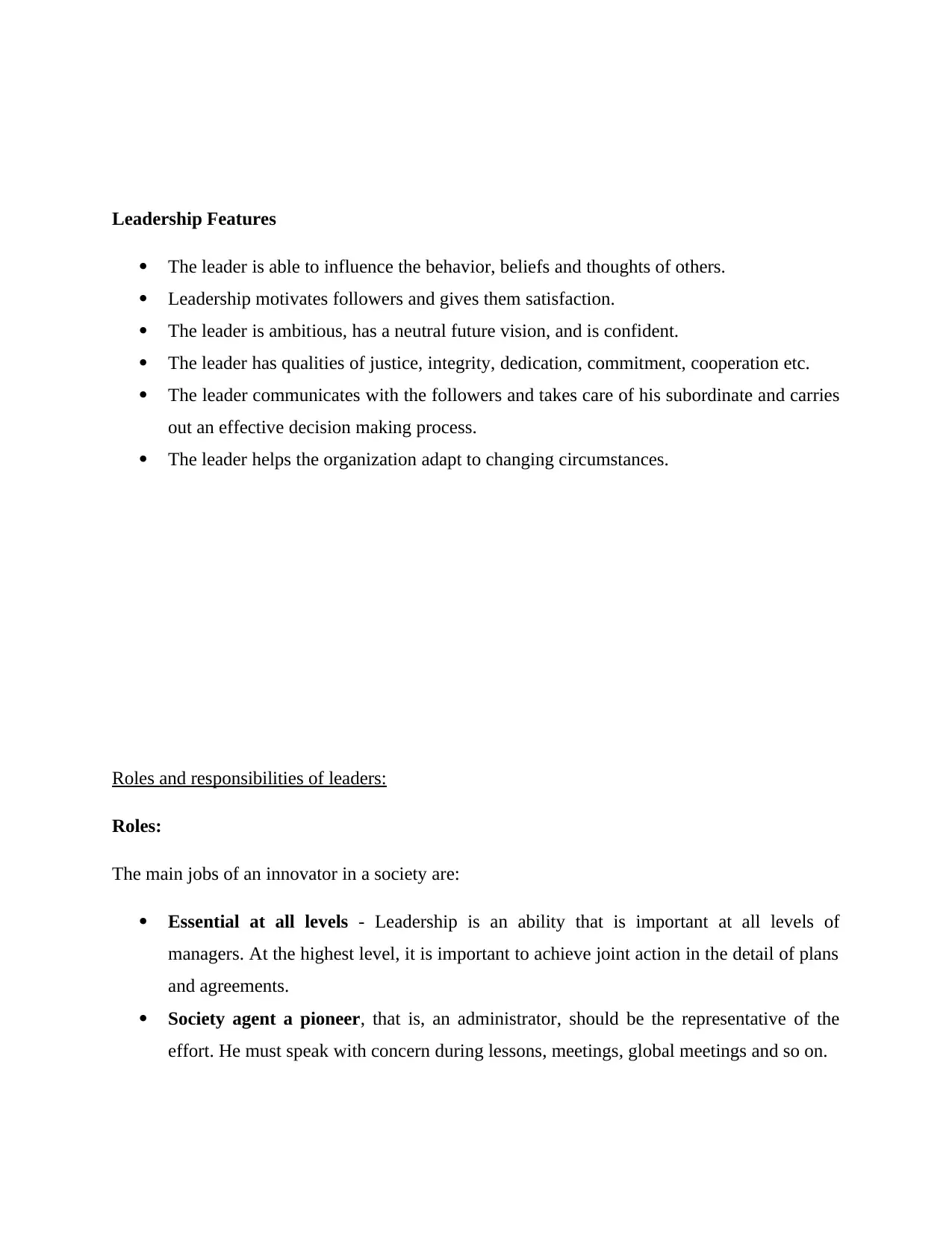
Leadership Features
The leader is able to influence the behavior, beliefs and thoughts of others.
Leadership motivates followers and gives them satisfaction.
The leader is ambitious, has a neutral future vision, and is confident.
The leader has qualities of justice, integrity, dedication, commitment, cooperation etc.
The leader communicates with the followers and takes care of his subordinate and carries
out an effective decision making process.
The leader helps the organization adapt to changing circumstances.
Roles and responsibilities of leaders:
Roles:
The main jobs of an innovator in a society are:
Essential at all levels - Leadership is an ability that is important at all levels of
managers. At the highest level, it is important to achieve joint action in the detail of plans
and agreements.
Society agent a pioneer, that is, an administrator, should be the representative of the
effort. He must speak with concern during lessons, meetings, global meetings and so on.
The leader is able to influence the behavior, beliefs and thoughts of others.
Leadership motivates followers and gives them satisfaction.
The leader is ambitious, has a neutral future vision, and is confident.
The leader has qualities of justice, integrity, dedication, commitment, cooperation etc.
The leader communicates with the followers and takes care of his subordinate and carries
out an effective decision making process.
The leader helps the organization adapt to changing circumstances.
Roles and responsibilities of leaders:
Roles:
The main jobs of an innovator in a society are:
Essential at all levels - Leadership is an ability that is important at all levels of
managers. At the highest level, it is important to achieve joint action in the detail of plans
and agreements.
Society agent a pioneer, that is, an administrator, should be the representative of the
effort. He must speak with concern during lessons, meetings, global meetings and so on.
⊘ This is a preview!⊘
Do you want full access?
Subscribe today to unlock all pages.

Trusted by 1+ million students worldwide
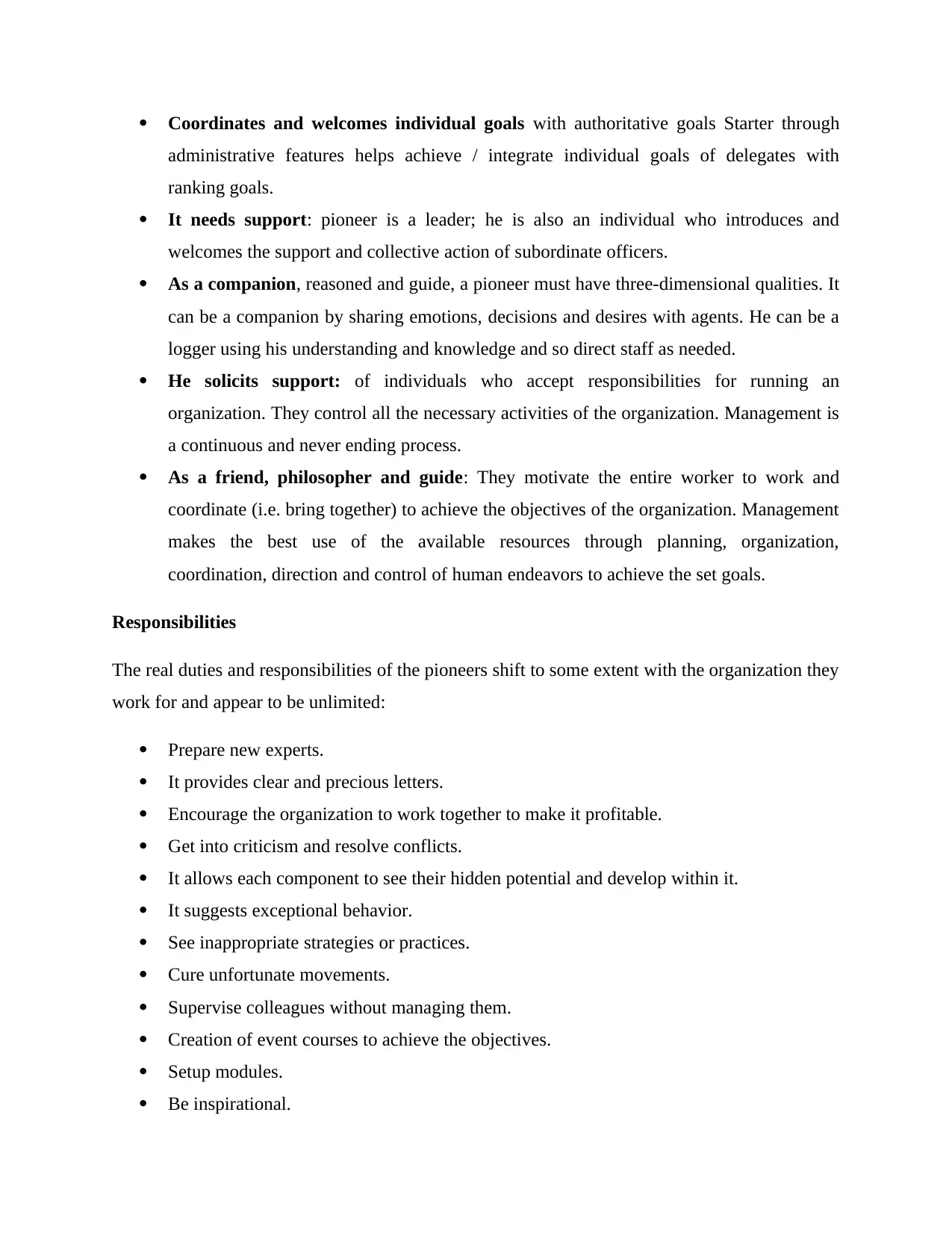
Coordinates and welcomes individual goals with authoritative goals Starter through
administrative features helps achieve / integrate individual goals of delegates with
ranking goals.
It needs support: pioneer is a leader; he is also an individual who introduces and
welcomes the support and collective action of subordinate officers.
As a companion, reasoned and guide, a pioneer must have three-dimensional qualities. It
can be a companion by sharing emotions, decisions and desires with agents. He can be a
logger using his understanding and knowledge and so direct staff as needed.
He solicits support: of individuals who accept responsibilities for running an
organization. They control all the necessary activities of the organization. Management is
a continuous and never ending process.
As a friend, philosopher and guide: They motivate the entire worker to work and
coordinate (i.e. bring together) to achieve the objectives of the organization. Management
makes the best use of the available resources through planning, organization,
coordination, direction and control of human endeavors to achieve the set goals.
Responsibilities
The real duties and responsibilities of the pioneers shift to some extent with the organization they
work for and appear to be unlimited:
Prepare new experts.
It provides clear and precious letters.
Encourage the organization to work together to make it profitable.
Get into criticism and resolve conflicts.
It allows each component to see their hidden potential and develop within it.
It suggests exceptional behavior.
See inappropriate strategies or practices.
Cure unfortunate movements.
Supervise colleagues without managing them.
Creation of event courses to achieve the objectives.
Setup modules.
Be inspirational.
administrative features helps achieve / integrate individual goals of delegates with
ranking goals.
It needs support: pioneer is a leader; he is also an individual who introduces and
welcomes the support and collective action of subordinate officers.
As a companion, reasoned and guide, a pioneer must have three-dimensional qualities. It
can be a companion by sharing emotions, decisions and desires with agents. He can be a
logger using his understanding and knowledge and so direct staff as needed.
He solicits support: of individuals who accept responsibilities for running an
organization. They control all the necessary activities of the organization. Management is
a continuous and never ending process.
As a friend, philosopher and guide: They motivate the entire worker to work and
coordinate (i.e. bring together) to achieve the objectives of the organization. Management
makes the best use of the available resources through planning, organization,
coordination, direction and control of human endeavors to achieve the set goals.
Responsibilities
The real duties and responsibilities of the pioneers shift to some extent with the organization they
work for and appear to be unlimited:
Prepare new experts.
It provides clear and precious letters.
Encourage the organization to work together to make it profitable.
Get into criticism and resolve conflicts.
It allows each component to see their hidden potential and develop within it.
It suggests exceptional behavior.
See inappropriate strategies or practices.
Cure unfortunate movements.
Supervise colleagues without managing them.
Creation of event courses to achieve the objectives.
Setup modules.
Be inspirational.
Paraphrase This Document
Need a fresh take? Get an instant paraphrase of this document with our AI Paraphraser
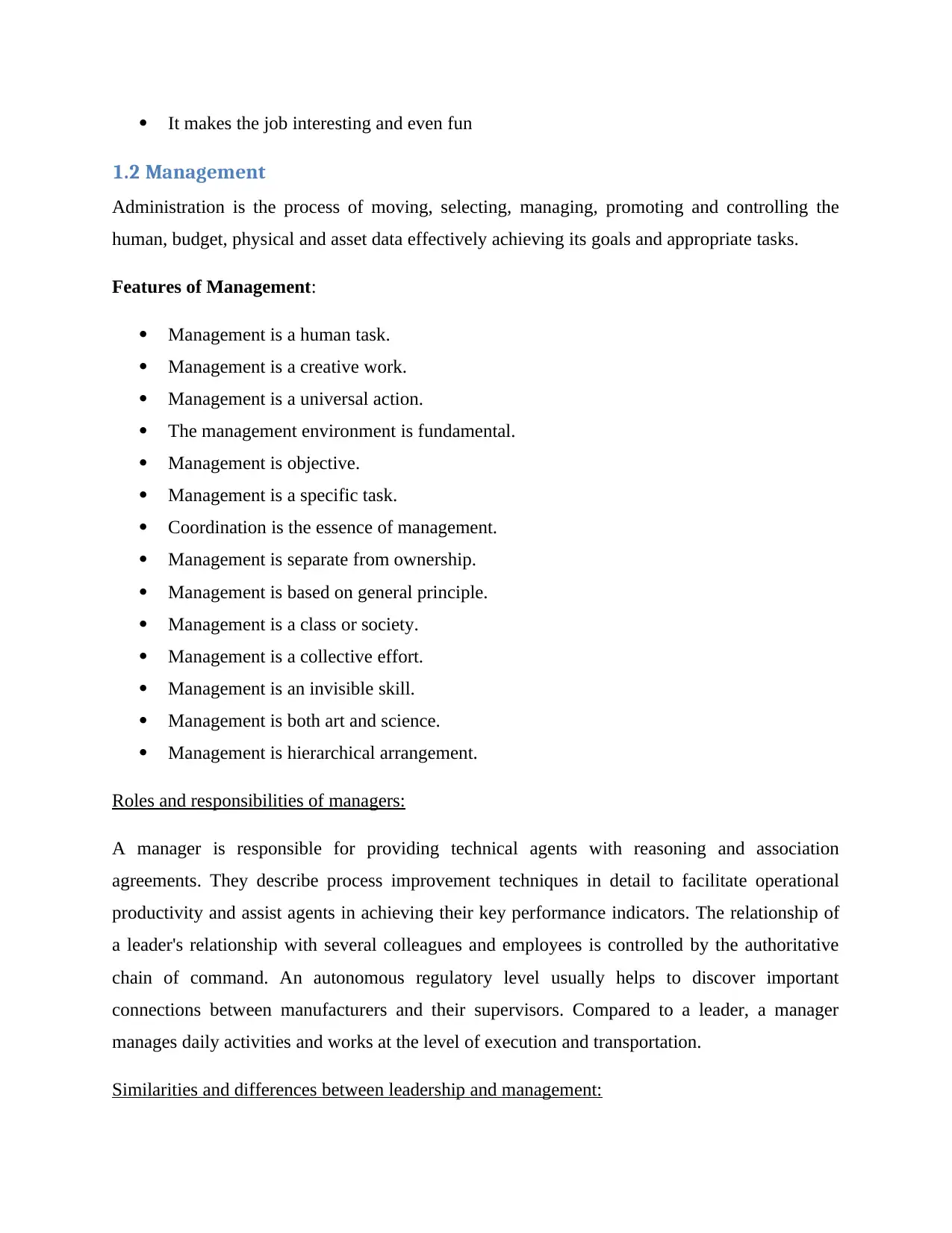
It makes the job interesting and even fun
1.2 Management
Administration is the process of moving, selecting, managing, promoting and controlling the
human, budget, physical and asset data effectively achieving its goals and appropriate tasks.
Features of Management:
Management is a human task.
Management is a creative work.
Management is a universal action.
The management environment is fundamental.
Management is objective.
Management is a specific task.
Coordination is the essence of management.
Management is separate from ownership.
Management is based on general principle.
Management is a class or society.
Management is a collective effort.
Management is an invisible skill.
Management is both art and science.
Management is hierarchical arrangement.
Roles and responsibilities of managers:
A manager is responsible for providing technical agents with reasoning and association
agreements. They describe process improvement techniques in detail to facilitate operational
productivity and assist agents in achieving their key performance indicators. The relationship of
a leader's relationship with several colleagues and employees is controlled by the authoritative
chain of command. An autonomous regulatory level usually helps to discover important
connections between manufacturers and their supervisors. Compared to a leader, a manager
manages daily activities and works at the level of execution and transportation.
Similarities and differences between leadership and management:
1.2 Management
Administration is the process of moving, selecting, managing, promoting and controlling the
human, budget, physical and asset data effectively achieving its goals and appropriate tasks.
Features of Management:
Management is a human task.
Management is a creative work.
Management is a universal action.
The management environment is fundamental.
Management is objective.
Management is a specific task.
Coordination is the essence of management.
Management is separate from ownership.
Management is based on general principle.
Management is a class or society.
Management is a collective effort.
Management is an invisible skill.
Management is both art and science.
Management is hierarchical arrangement.
Roles and responsibilities of managers:
A manager is responsible for providing technical agents with reasoning and association
agreements. They describe process improvement techniques in detail to facilitate operational
productivity and assist agents in achieving their key performance indicators. The relationship of
a leader's relationship with several colleagues and employees is controlled by the authoritative
chain of command. An autonomous regulatory level usually helps to discover important
connections between manufacturers and their supervisors. Compared to a leader, a manager
manages daily activities and works at the level of execution and transportation.
Similarities and differences between leadership and management:
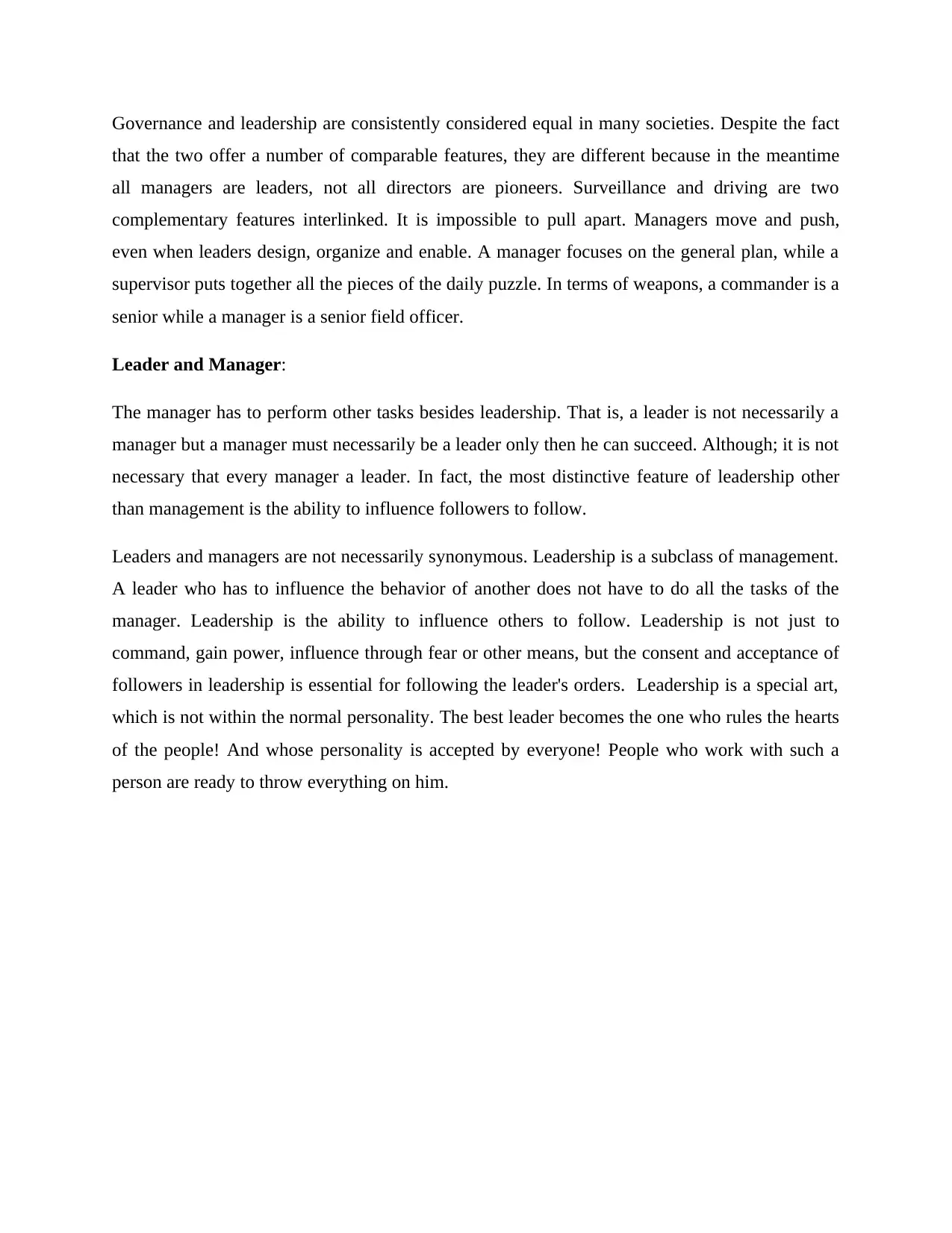
Governance and leadership are consistently considered equal in many societies. Despite the fact
that the two offer a number of comparable features, they are different because in the meantime
all managers are leaders, not all directors are pioneers. Surveillance and driving are two
complementary features interlinked. It is impossible to pull apart. Managers move and push,
even when leaders design, organize and enable. A manager focuses on the general plan, while a
supervisor puts together all the pieces of the daily puzzle. In terms of weapons, a commander is a
senior while a manager is a senior field officer.
Leader and Manager:
The manager has to perform other tasks besides leadership. That is, a leader is not necessarily a
manager but a manager must necessarily be a leader only then he can succeed. Although; it is not
necessary that every manager a leader. In fact, the most distinctive feature of leadership other
than management is the ability to influence followers to follow.
Leaders and managers are not necessarily synonymous. Leadership is a subclass of management.
A leader who has to influence the behavior of another does not have to do all the tasks of the
manager. Leadership is the ability to influence others to follow. Leadership is not just to
command, gain power, influence through fear or other means, but the consent and acceptance of
followers in leadership is essential for following the leader's orders. Leadership is a special art,
which is not within the normal personality. The best leader becomes the one who rules the hearts
of the people! And whose personality is accepted by everyone! People who work with such a
person are ready to throw everything on him.
that the two offer a number of comparable features, they are different because in the meantime
all managers are leaders, not all directors are pioneers. Surveillance and driving are two
complementary features interlinked. It is impossible to pull apart. Managers move and push,
even when leaders design, organize and enable. A manager focuses on the general plan, while a
supervisor puts together all the pieces of the daily puzzle. In terms of weapons, a commander is a
senior while a manager is a senior field officer.
Leader and Manager:
The manager has to perform other tasks besides leadership. That is, a leader is not necessarily a
manager but a manager must necessarily be a leader only then he can succeed. Although; it is not
necessary that every manager a leader. In fact, the most distinctive feature of leadership other
than management is the ability to influence followers to follow.
Leaders and managers are not necessarily synonymous. Leadership is a subclass of management.
A leader who has to influence the behavior of another does not have to do all the tasks of the
manager. Leadership is the ability to influence others to follow. Leadership is not just to
command, gain power, influence through fear or other means, but the consent and acceptance of
followers in leadership is essential for following the leader's orders. Leadership is a special art,
which is not within the normal personality. The best leader becomes the one who rules the hearts
of the people! And whose personality is accepted by everyone! People who work with such a
person are ready to throw everything on him.
⊘ This is a preview!⊘
Do you want full access?
Subscribe today to unlock all pages.

Trusted by 1+ million students worldwide
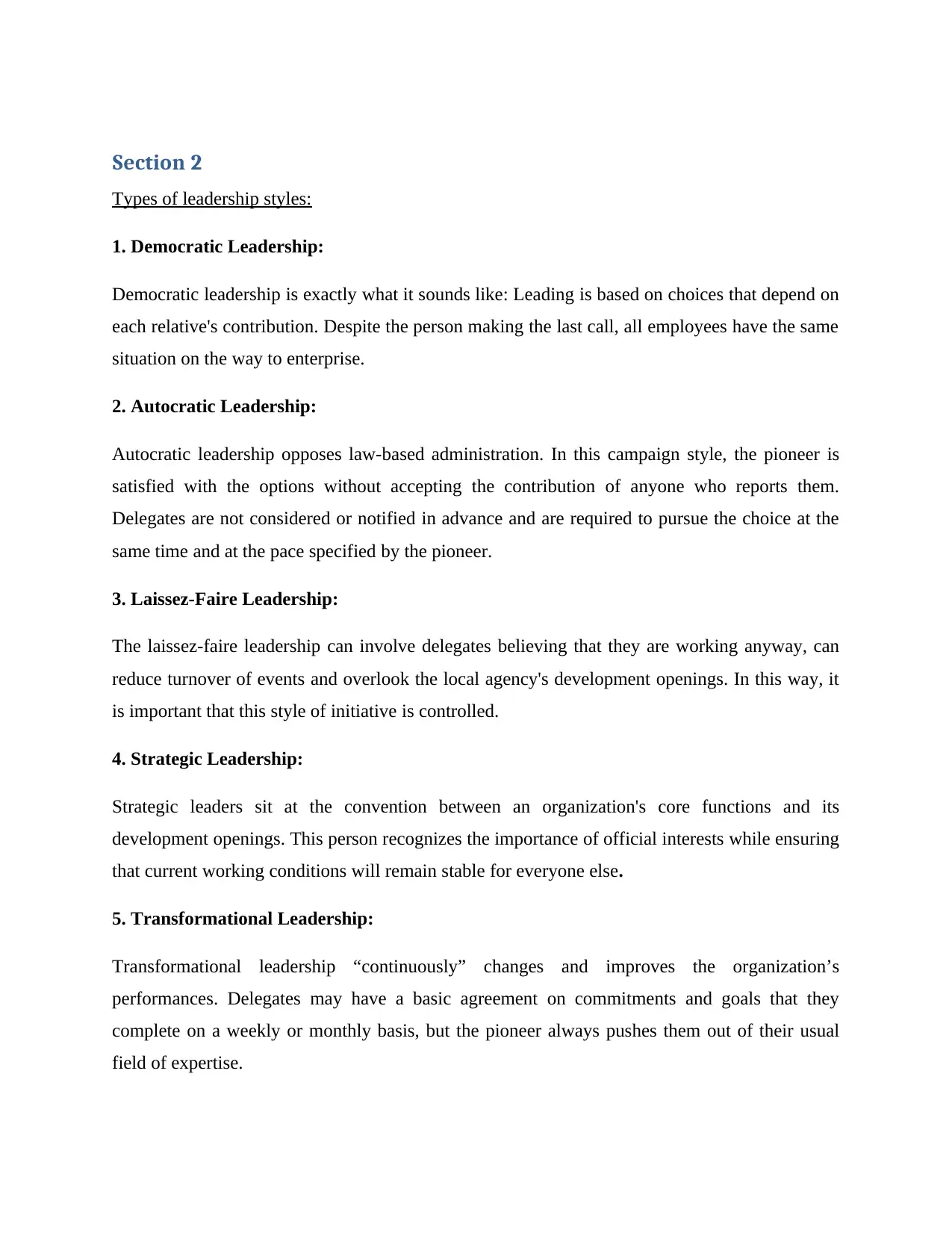
Section 2
Types of leadership styles:
1. Democratic Leadership:
Democratic leadership is exactly what it sounds like: Leading is based on choices that depend on
each relative's contribution. Despite the person making the last call, all employees have the same
situation on the way to enterprise.
2. Autocratic Leadership:
Autocratic leadership opposes law-based administration. In this campaign style, the pioneer is
satisfied with the options without accepting the contribution of anyone who reports them.
Delegates are not considered or notified in advance and are required to pursue the choice at the
same time and at the pace specified by the pioneer.
3. Laissez-Faire Leadership:
The laissez-faire leadership can involve delegates believing that they are working anyway, can
reduce turnover of events and overlook the local agency's development openings. In this way, it
is important that this style of initiative is controlled.
4. Strategic Leadership:
Strategic leaders sit at the convention between an organization's core functions and its
development openings. This person recognizes the importance of official interests while ensuring
that current working conditions will remain stable for everyone else.
5. Transformational Leadership:
Transformational leadership “continuously” changes and improves the organization’s
performances. Delegates may have a basic agreement on commitments and goals that they
complete on a weekly or monthly basis, but the pioneer always pushes them out of their usual
field of expertise.
Types of leadership styles:
1. Democratic Leadership:
Democratic leadership is exactly what it sounds like: Leading is based on choices that depend on
each relative's contribution. Despite the person making the last call, all employees have the same
situation on the way to enterprise.
2. Autocratic Leadership:
Autocratic leadership opposes law-based administration. In this campaign style, the pioneer is
satisfied with the options without accepting the contribution of anyone who reports them.
Delegates are not considered or notified in advance and are required to pursue the choice at the
same time and at the pace specified by the pioneer.
3. Laissez-Faire Leadership:
The laissez-faire leadership can involve delegates believing that they are working anyway, can
reduce turnover of events and overlook the local agency's development openings. In this way, it
is important that this style of initiative is controlled.
4. Strategic Leadership:
Strategic leaders sit at the convention between an organization's core functions and its
development openings. This person recognizes the importance of official interests while ensuring
that current working conditions will remain stable for everyone else.
5. Transformational Leadership:
Transformational leadership “continuously” changes and improves the organization’s
performances. Delegates may have a basic agreement on commitments and goals that they
complete on a weekly or monthly basis, but the pioneer always pushes them out of their usual
field of expertise.
Paraphrase This Document
Need a fresh take? Get an instant paraphrase of this document with our AI Paraphraser
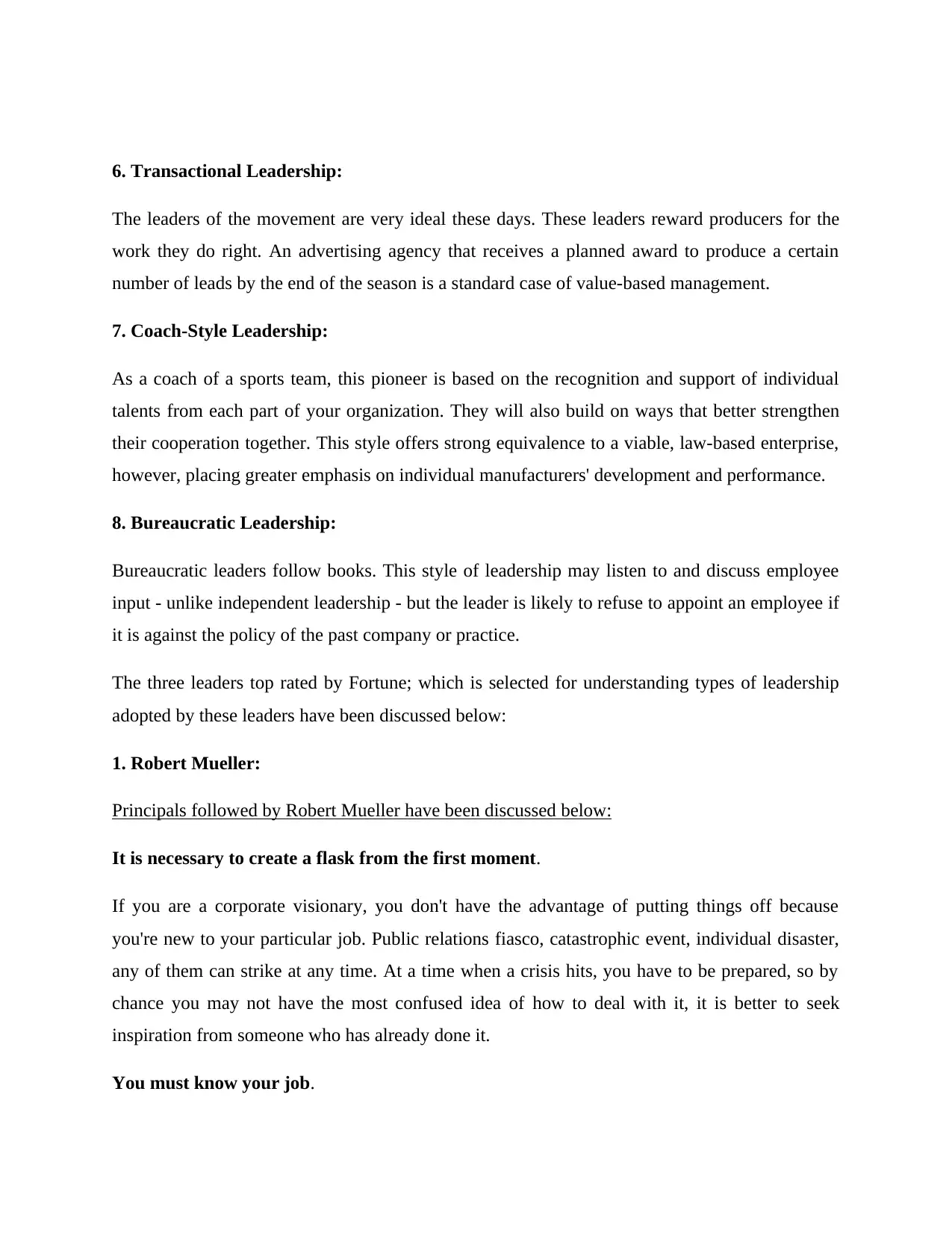
6. Transactional Leadership:
The leaders of the movement are very ideal these days. These leaders reward producers for the
work they do right. An advertising agency that receives a planned award to produce a certain
number of leads by the end of the season is a standard case of value-based management.
7. Coach-Style Leadership:
As a coach of a sports team, this pioneer is based on the recognition and support of individual
talents from each part of your organization. They will also build on ways that better strengthen
their cooperation together. This style offers strong equivalence to a viable, law-based enterprise,
however, placing greater emphasis on individual manufacturers' development and performance.
8. Bureaucratic Leadership:
Bureaucratic leaders follow books. This style of leadership may listen to and discuss employee
input - unlike independent leadership - but the leader is likely to refuse to appoint an employee if
it is against the policy of the past company or practice.
The three leaders top rated by Fortune; which is selected for understanding types of leadership
adopted by these leaders have been discussed below:
1. Robert Mueller:
Principals followed by Robert Mueller have been discussed below:
It is necessary to create a flask from the first moment.
If you are a corporate visionary, you don't have the advantage of putting things off because
you're new to your particular job. Public relations fiasco, catastrophic event, individual disaster,
any of them can strike at any time. At a time when a crisis hits, you have to be prepared, so by
chance you may not have the most confused idea of how to deal with it, it is better to seek
inspiration from someone who has already done it.
You must know your job.
The leaders of the movement are very ideal these days. These leaders reward producers for the
work they do right. An advertising agency that receives a planned award to produce a certain
number of leads by the end of the season is a standard case of value-based management.
7. Coach-Style Leadership:
As a coach of a sports team, this pioneer is based on the recognition and support of individual
talents from each part of your organization. They will also build on ways that better strengthen
their cooperation together. This style offers strong equivalence to a viable, law-based enterprise,
however, placing greater emphasis on individual manufacturers' development and performance.
8. Bureaucratic Leadership:
Bureaucratic leaders follow books. This style of leadership may listen to and discuss employee
input - unlike independent leadership - but the leader is likely to refuse to appoint an employee if
it is against the policy of the past company or practice.
The three leaders top rated by Fortune; which is selected for understanding types of leadership
adopted by these leaders have been discussed below:
1. Robert Mueller:
Principals followed by Robert Mueller have been discussed below:
It is necessary to create a flask from the first moment.
If you are a corporate visionary, you don't have the advantage of putting things off because
you're new to your particular job. Public relations fiasco, catastrophic event, individual disaster,
any of them can strike at any time. At a time when a crisis hits, you have to be prepared, so by
chance you may not have the most confused idea of how to deal with it, it is better to seek
inspiration from someone who has already done it.
You must know your job.
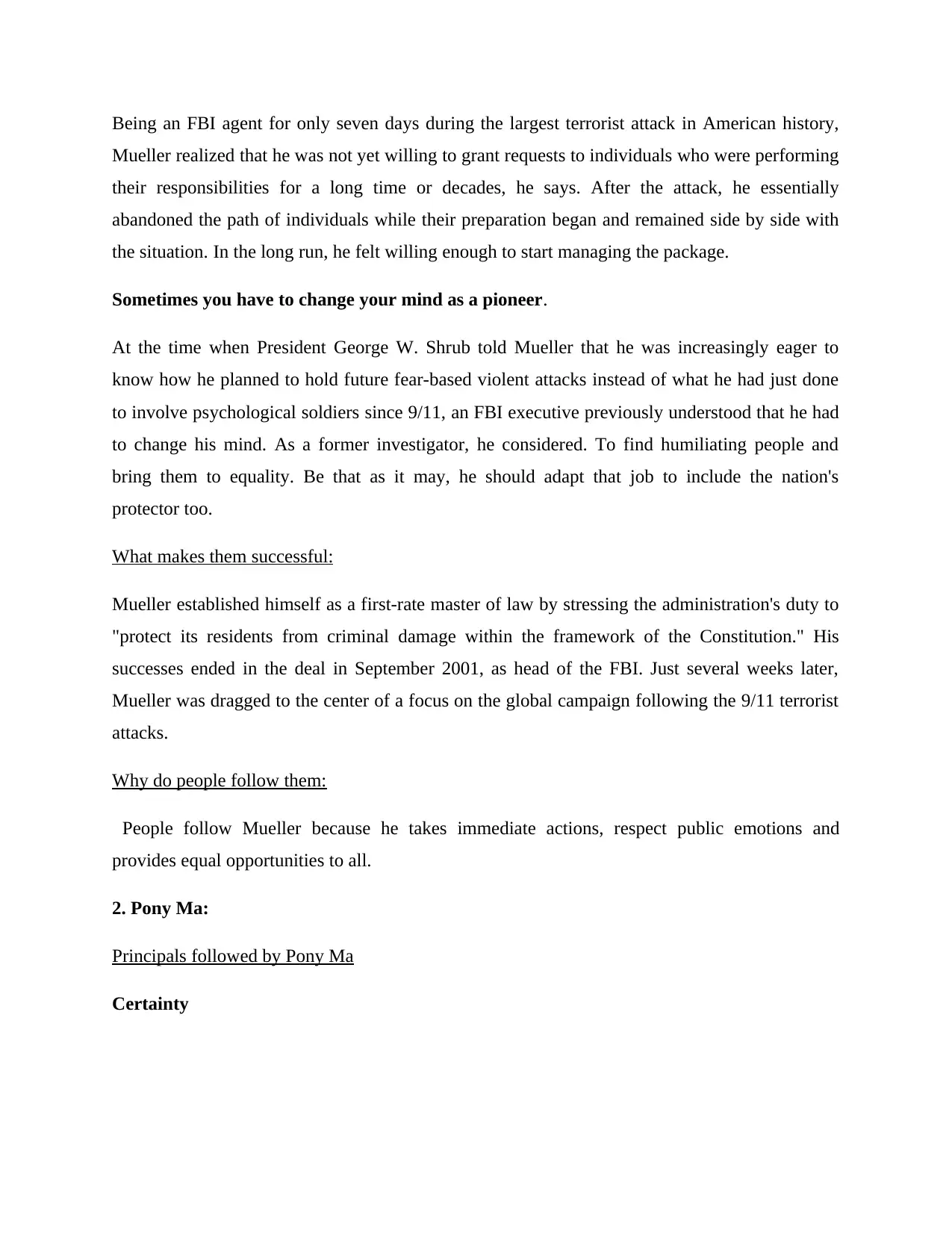
Being an FBI agent for only seven days during the largest terrorist attack in American history,
Mueller realized that he was not yet willing to grant requests to individuals who were performing
their responsibilities for a long time or decades, he says. After the attack, he essentially
abandoned the path of individuals while their preparation began and remained side by side with
the situation. In the long run, he felt willing enough to start managing the package.
Sometimes you have to change your mind as a pioneer.
At the time when President George W. Shrub told Mueller that he was increasingly eager to
know how he planned to hold future fear-based violent attacks instead of what he had just done
to involve psychological soldiers since 9/11, an FBI executive previously understood that he had
to change his mind. As a former investigator, he considered. To find humiliating people and
bring them to equality. Be that as it may, he should adapt that job to include the nation's
protector too.
What makes them successful:
Mueller established himself as a first-rate master of law by stressing the administration's duty to
"protect its residents from criminal damage within the framework of the Constitution." His
successes ended in the deal in September 2001, as head of the FBI. Just several weeks later,
Mueller was dragged to the center of a focus on the global campaign following the 9/11 terrorist
attacks.
Why do people follow them:
People follow Mueller because he takes immediate actions, respect public emotions and
provides equal opportunities to all.
2. Pony Ma:
Principals followed by Pony Ma
Certainty
Mueller realized that he was not yet willing to grant requests to individuals who were performing
their responsibilities for a long time or decades, he says. After the attack, he essentially
abandoned the path of individuals while their preparation began and remained side by side with
the situation. In the long run, he felt willing enough to start managing the package.
Sometimes you have to change your mind as a pioneer.
At the time when President George W. Shrub told Mueller that he was increasingly eager to
know how he planned to hold future fear-based violent attacks instead of what he had just done
to involve psychological soldiers since 9/11, an FBI executive previously understood that he had
to change his mind. As a former investigator, he considered. To find humiliating people and
bring them to equality. Be that as it may, he should adapt that job to include the nation's
protector too.
What makes them successful:
Mueller established himself as a first-rate master of law by stressing the administration's duty to
"protect its residents from criminal damage within the framework of the Constitution." His
successes ended in the deal in September 2001, as head of the FBI. Just several weeks later,
Mueller was dragged to the center of a focus on the global campaign following the 9/11 terrorist
attacks.
Why do people follow them:
People follow Mueller because he takes immediate actions, respect public emotions and
provides equal opportunities to all.
2. Pony Ma:
Principals followed by Pony Ma
Certainty
⊘ This is a preview!⊘
Do you want full access?
Subscribe today to unlock all pages.

Trusted by 1+ million students worldwide
1 out of 19
Related Documents
Your All-in-One AI-Powered Toolkit for Academic Success.
+13062052269
info@desklib.com
Available 24*7 on WhatsApp / Email
![[object Object]](/_next/static/media/star-bottom.7253800d.svg)
Unlock your academic potential
Copyright © 2020–2025 A2Z Services. All Rights Reserved. Developed and managed by ZUCOL.





